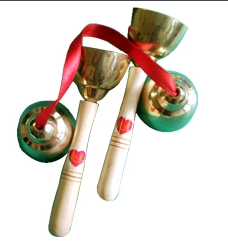Playing skills and application of bells
880 views · Organized by 钟离 on 2022-02-08
When playing, each hand holds a bell, and the bell is raised up in front of the chest.
Although the bell has no fixed pitch, the sound is cool, and it is often played with elegant and lyrical tunes. It is mostly used for folk instrumental ensembles such as Jiangnan Sizhu, Cantonese music, Shifan gongs and drums, Zhedong wind and beat, Fujian Nanyin, Fujian Nanyin, Liaonan drum, Shandong drum, Xi'an drum and other folk instrumental ensembles, and local operas and songs and dances such as Peking Opera, Hebei Bangzi, Jin Opera, Sichuan Opera, etc. accompaniment.
In the Peking Opera Wenchang Band, the bells are used in the anti-erhuangli sung by Tsing Yi, often with the rhythm in the singing, and the drums in the passage. It is often used in ensemble or accompaniment with small wooden fish. In Tibetan areas, bells are used in Duixie and Nangma songs and dances, and are often played by female artists while singing.
The Naxi people use it for Taoist Dongjing music. The bell is also a religious instrument, used in Buddhist temples and other religious activities such as chanting, and some temples only use a single bell, which is struck by the right hand. The ping bell is a color and rhythm musical instrument with special charm in our country's mutual striking body sounding instruments.
Play a body music instrument. It is widely used as percussion instrument in Chinese song and dance, opera music accompaniment and folk instrumental ensemble.
Although the bell has no fixed pitch, the sound is cool, and it is often played with elegant and lyrical tunes. It is mostly used for folk instrumental ensembles such as Jiangnan Sizhu, Cantonese music, Shifan gongs and drums, Zhedong wind and beat, Fujian Nanyin, Fujian Nanyin, Liaonan drum, Shandong drum, Xi'an drum and other folk instrumental ensembles, and local operas and songs and dances such as Peking Opera, Hebei Bangzi, Jin Opera, Sichuan Opera, etc. accompaniment.

In the Peking Opera Wenchang Band, the bells are used in the anti-erhuangli sung by Tsing Yi, often with the rhythm in the singing, and the drums in the passage. It is often used in ensemble or accompaniment with small wooden fish. In Tibetan areas, bells are used in Duixie and Nangma songs and dances, and are often played by female artists while singing.
The Naxi people use it for Taoist Dongjing music. The bell is also a religious instrument, used in Buddhist temples and other religious activities such as chanting, and some temples only use a single bell, which is struck by the right hand. The ping bell is a color and rhythm musical instrument with special charm in our country's mutual striking body sounding instruments.
Play a body music instrument. It is widely used as percussion instrument in Chinese song and dance, opera music accompaniment and folk instrumental ensemble.
Involving musical instruments
The bell (pinyin: Pèng líng) was called bell cymbal in ancient times. It is a musical instrument of Manchu, Mongolian, Tibetan, Naxi, Han and other ethnic groups. Tibetan called Dingxia. Due to the difference in the spread of the region, in the folk there are names such as jingling, double chime, sound and water, etc. In Shaanxi, it is called dangzi, and there are also called bells for short. It is shaped like a bell, made of copper, one pair of two, connected by ropes, collided with each other and pronounced without a fixed pitch. Often used in instrumental ensembles and opera accompaniment, it is a rhythm instrument.
 渝公网安备 50010702504639号
渝公网安备 50010702504639号